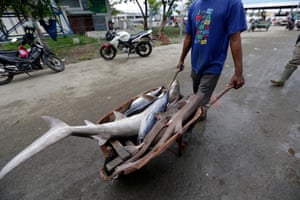The world has failed to meet a single target to stem the destruction of wildlife and life-sustaining ecosystems in the last decade, according to a devastating new report from the UN on the state of nature.
From tackling pollution to protecting coral reefs, the international community did not fully achieve any of the 20 Aichi biodiversity targets agreed in Japan in 2010 to slow the loss of the natural world. It is the second consecutive decade that governments have failed to meet targets.
The Global Biodiversity Outlook 5, published before a key UN summit on the issue later this month, found that despite progress in some areas, natural habitats have continued to disappear, vast numbers of species remain threatened by extinction from human activities, and $500bn (GBP388bn) of environmentally damaging government subsidies have not been eliminated.
Six targets have been partially achieved, including those on protected areas and invasive species. While governments did not manage to protect 17% of terrestrial and inland water areas and 10% of marine habitats, 44% of vital biodiverse areas are now under protection, an increase from 29% in 2000. About 200 successful eradications of invasive species on islands have also taken place.
The UN said the natural world was deteriorating and failure to act could undermine the goals of the Paris agreement on the climate crisis and the sustainable development goals.
The UN’s biodiversity head, Elizabeth Maruma Mrema, said humanity was at a crossroads that would decide how future generations experience the natural world.
“Earth’s living systems as a whole are being compromised. And the more humanity exploits nature in unsustainable ways and undermines its contributions to people, the more we undermine our own wellbeing, security and prosperity,” she said.
The report is the third in a week to highlight the devastating state of the planet. The WWF and Zoological Society of London (ZSL)’s Living Planet Report 2020 said global wildlife populations were in freefall, plunging by two-thirds, because of human overconsumption, population growth and intensive agriculture. On Monday, the RSPB said the UK had failed to reach 17 of the Aichi targets and that the gap between rhetoric and reality had resulted in a “lost decade for nature”.
The 20 Aichi biodiversity targets are broken down into 60 separate elements to monitor overall progress. Of those, seven have been achieved, 38 have shown progress and 13 elements have shown no progress. Progress remains unknown for two elements.

A leading target to halve the loss of natural habitats, including forests, has not been met. While global deforestation rates have decreased by about a third in the past five years compared with pre-2010 levels, the degradation and fragmentation of biodiversity-rich ecosystems in the tropics remains high. Wilderness areas and wetlands have continued to disappear and freshwater ecosystems remain critically threatened.
Half a trillion dollars of harmful government subsidies for agriculture, fossil fuels and fishing are highlighted in the report as a particular area of concern by its lead author, David Cooper, deputy executive secretary of the Convention on Biological Diversity.
“We are still seeing so much more public money invested in things that harm biodiversity than in things that support biodiversity,” he said.
Although there has been progress in some regions, the proportion of overfished marine stocks has increased in the last decade to a third of the total, and many non-target species are threatened because of unsustainable levels of bycatch. As a result, the target to sustainably manage and harvest all fish and invertebrate stocks has not been met.
Plastic waste and excess nutrients have not been brought to levels that do not damage ecosystem function and biodiversity around the world, according to the report. About 260,000 tonnes of plastic particles have accumulated in oceans with severe impacts on marine ecosystems, often with unknown implications. Electronics pollution is also highlighted as an issue of increasing concern, fuelled by high consumption rates.
More than 60% of the world’s coral reefs are under threat, especially because of overfishing and destructive practices, and a 2015 target to minimise threats was missed. It was also missed in 2020, with the climate crisis, ocean acidification and costal development blamed for their poor state.

The target on protecting life-sustaining ecosystems while taking into account the needs of women, indigenous communities and poor people were not met. The assessment of the state of nature on Earth found ecosystems that provide clean water, medicine and support livelihoods have not been protected, disproportionally affecting women and vulnerable communities.
The report authors, however, pointed to the conservation efforts that led to as many as 48 species being saved from extinction in recent decades as a sign of hope.
Cooper said: “Hidden behind those global aggregates there is important progress and, you know, that gives us signs that if you do put policies in place, they do work.”
He added that the failure to meet the targets was down to certain governments not understanding the scale of the challenge faced by the natural world. “I think countries are taking it seriously, but perhaps sometimes they’re leaving it to the environment ministries and not elevating this enough to something that’s got to be the whole of government.”
The report comes as parties to the Convention on Biological Diversity negotiate the targets for this decade. The final round of negotiations for agreement had been scheduled to take place in Kunming, China, last October but have been delayed by the coronavirus pandemic and are now expected to take place in May 2021. A significant part of the draft proposal is to protect 30% of the planet.
Q&A What is the Kunming biodiversity conference 2021?
Show
Hide
In 2021, hundreds of biodiversity experts and government ministers are expected to negotiate new targets on biodiversity for this decade at a meeting in the Chinese city of Kunming. The aim of the accord, “a Paris agreement for nature”, is to stop and reverse rampant biodiversity loss around the world.
Why is it a big deal?
In 2017 scientists warned humans are causing the sixth mass extinction in the Earth’s history. Now the UN has reported that the world has failed to meet a single target agreed a decade ago to stem the destruction of wildlife and life-sustaining ecosystems.
Are only governments worried?
No. At the 2020 World Economic Forum, business leaders warned biodiversity loss was the third biggest risk to the world in terms of likelihood and severity, ahead of infectious diseases, terror attacks and interstate conflict.
What might the Kunming agreement look like?
In January, the UN Convention on Biological Diversity published a 20-point draft of the agreement. It commits signatories to protect at least 30% of the planet, introduce controls on invasive species and reduce pollution from plastic waste and excess nutrients by 50%. Critics, however, say this does not go far enough.
Is this agreement part of a long term plan?
Yes. The UN has an overarching plan that humanity should be living in harmony with nature by 2050. The 2030 goals relate to that ambition in five ways: ensuring no net losses in the integrity and size of freshwater, marine and terrestrial ecosystems; reducing the number of species threatened with extinction; enhancing genetic diversity; achieving the targets of the Paris Agreement; and sharing the benefits of genetic resources and traditional knowledge.
Basile van Havre, a co-chair of the negotiations, said one of the main lessons of the Aichi biodiversity targets was that the next set must be achievable.
“I think it was a very laudable objective to set aspirational targets in the last decades. They’re hard to reach and clearly you hear that people want to have realistic targets,” he said.
Find more age of extinction coverage here, and follow biodiversity reporters Phoebe Weston and Patrick Greenfield on Twitter for all the latest news and features